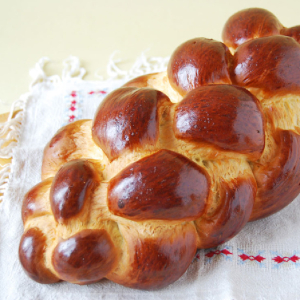Yesterday, we surveyed what Hungariophiles (my word) consider the top main dishes from that ancient and colourful land. Today, we’ll look at the most popular daily breads and desserts. They’re every bit as hearty and bold as the mains!
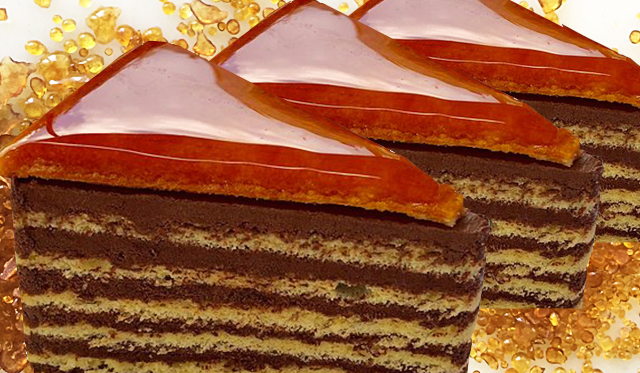 Hungary’s famous Dobos Torte: Thin layers of sponge cake and
Hungary’s famous Dobos Torte: Thin layers of sponge cake and
butter cream frosting, topped with hardened Carmel.
In Hungary, there are a few staple breads that everybody eats. They’re not hard to make, but do require some effort and time. And you have to try them if you want to experience the true character of Hungarian daily life. And, if you thought Hungary was famous only for its spicy mains, you obviously haven’t tried their rich desserts!
On our menu today
Like diners of all cultures who love to sop up rich sauces with bread, Hungarians rely on their own classic types to accompany all meals. Unlike some cuisines we’ve already toured, though, they have agreed on just a handful of recipes which everyone enjoys.
Breads
Hungarians love their bread, and they focus mainly on three varieties, the recipes for which come down from ancient times. Each has its place in the Hungarian scheme of things, and each is considered indispensable! They also have their own versions of dinner rolls and biscuits…
Country Bread: This is the daily bread of Hungary, a large, round loaf that requires only four ingredients: wheat flour, water, salt and yeast. It’s a 2-rise recipe and, because you don’t bloom the yeast or add any sugar to the dough, it rises slowly. With 2 rises of up to 2 hours each, it basically takes all day to make. The result is a medium-dense loaf with a fine crumb and a crispy dark brown crust.
Krumplis Kenyér: Hungarian Potato Bread is another staple bread enjoyed in all parts of the country. It, too, is made in a large, round loaf, but the technique and ingredients differ significantly. You’ll need brad flour, yeast, salt, water and Russet (or other mealy potatoes) and Caraway Seeds. First, you bloom the yeast using a few spoonfuls of flour and water.
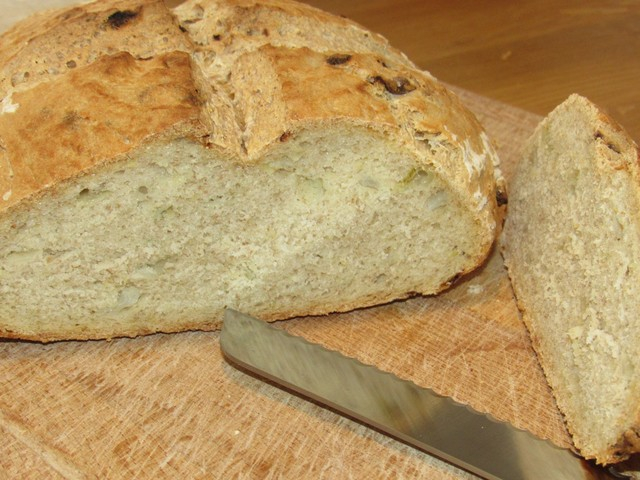
You boil the potatoes until soft and then rice them (or mash them thoroughly – almost into a purée). Reserve enough of the potato water to make a medium stiff dough. Add the other ingredients o the spuds and knead by hand or with a dough hook in your stand mixer for 10 minutes. Let rise for an hour or until doubled. Punch down and form into a loaf. Let rise half an hour in a cold oven, turn the oven on to 400 F, and bake for 45 minutes or so, until you have a nice golden brown crust. Great flavour!
Kalács: You’ll immediately think of Challah Bread when you see your first loaf of Kalács (see photo, top of page). In fact, it’s a close cousin and is made and eaten by just about everybody at Easter. The recipe calls for flour, yeast and salt. But milk is used in place of plain water, along with eggs and butter to create a brioche-style consistency. Another characteristic that sets Kalács aside from other breads is the fact that it’s braided (again, like Challah), usually using three stands of dough. If you’ve braided hair, you can braid Kalács. Unless you want to attempt some of the more fancy styles using 4 or 6 stands!
Kifli: When you think ‘dinner rolls’ in Hungary you think Kifli. They’re made of regular bread dough, but rolled and shaped like Croissantes.
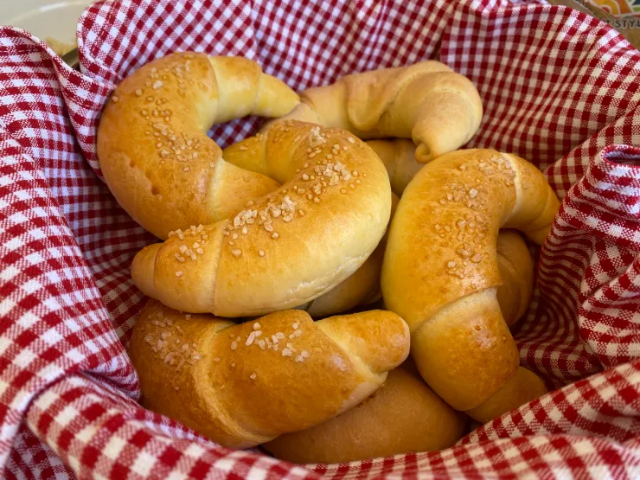
They’re usually eaten plain with butter, or split and stuffed with meat, cheese and peppers for a traditional sandwich.
Pogácsa: …And when you think biscuits, think Pogácsa! Also popular in Serbia, Croatia and Sovenia, these bite-sized, scone-like biscuits are enjoyed with meals, as appetizers or simply as a quick snack. The rich dough calls for flour, sugar, yeast, milk, sour cream, lard, salt, black pepper and shredded cheese (for topping). You must roll out the dough and fold it three times, allowing half an hour to rest after each of the first two folds – sort of like the procedure for puff pastry, but this us bread! The result is a wonderful multi-layered biscuit.
Deserts
Hungarians – like their German and Austrian cousins – love their sweets. The most popular of them fall into either the ‘breads’ or ‘cakes’ categories…
Gundel: Hungarian crèpes (Palacsinta) are stuffed with a filling of ground walnuts, raisins and rum, and topped with chocolate sauce.Palascinta are also enjoyed as a main or a snack, stuffed with meat and onions, and topped with a sour cream and Paprika sauce.
Kürtőskalács: Hungarian ‘Chimney Bread’ is a favourite meal topper or anytime snack. It’s a rolled dough formed around a cylindrical wooden mandrel and baked rotisserie-style over a bed of hot coals.
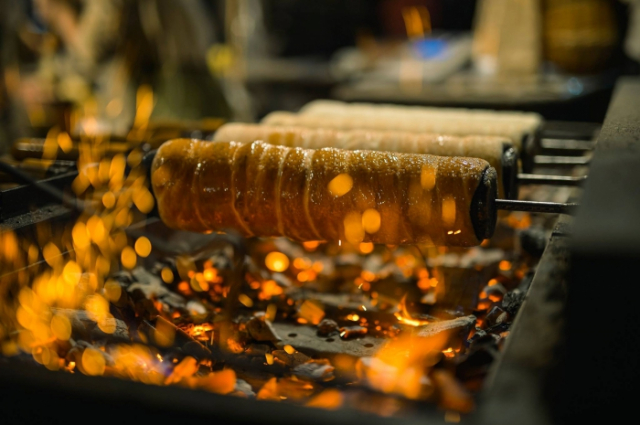
A top-rated Hungarian street food! It’s usually rolled in sugar or other garnishes including rolled in cinnamon, sugar, cocoa, nuts, or coconut flakes, and eaten hot and fresh from the fire.
Dobostorta: Dobos Torte, named after its creator, Hungarian baker József Dobos, is constructed of multiple layers of thin sponge cake separated by thick-ish layers of butter cream frosting. It’s traditionally topped with caramel and garnished with finely chopped nuts. Talk about decadent!
Meggyleves: Creamy, rich Sour Cherry Soup – a Hungarian original. It calls for only three ingredients: sour cherries, sugar and sour cream.
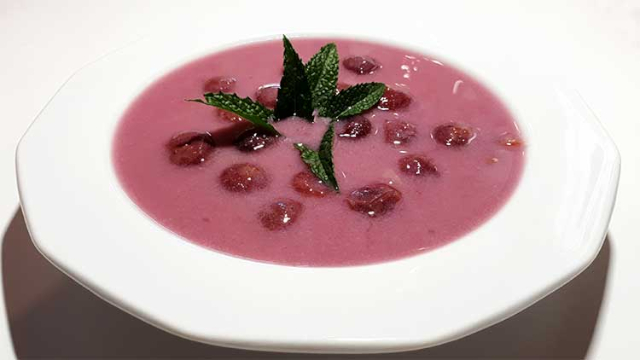
Meggyleves makes a great dessert, but it’s also enjoyed as conventional soup course; a refreshing foil for Hungary’s customary savoury mains.
Rétes: Hungary has its own version of that pan-Eastern-European treat, Strudel. And like its cousins, Hungarian Strudel was introduced by the Ottoman Turks. Thin, crispy dough is rolled around a filing of Poppy Seeds, Apples, Cherries or whatever you fancy. If you don’t have all day to make your own classic strudel dough, you can substitute store-bought Phyllo pastry without fear that anyone will notice.
Flódni: Why order four different desserts when you can get them all, each in its own layer, in a single slice of Flódni? This sumptuous desert is composed of layers of walnut paste, apple filling, poppy seeds and fruit jam.
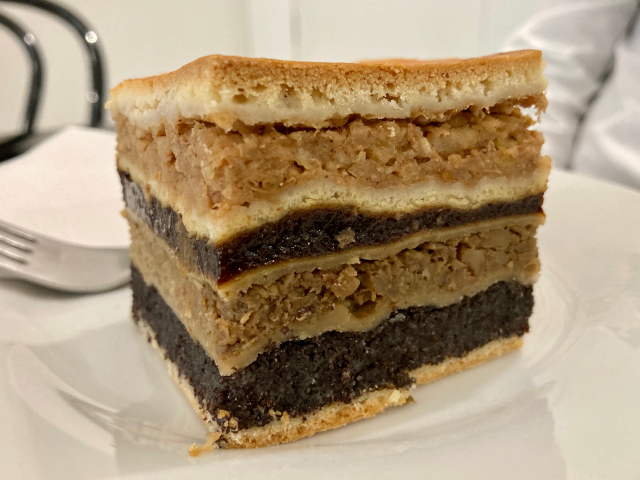
You can make your own pastry, to form a base and separate the filling layers, or opt for store-bought Phyllo. It’s another year-end holiday treat combining – as Eszter at szerbo.com relates – “every ingredient that might bring health and affluence for the new year according to the folk tradition.”
Reach out!
There’s plenty more to discover where the dishes above came from! I can confidently recommend szerbo.com as a starting place if you want to consult a comprehensive catalogue of authentic Hungarian cuisine. And don’t be afraid to Google any recipes that strike your fancy!
~ Maggie J.

